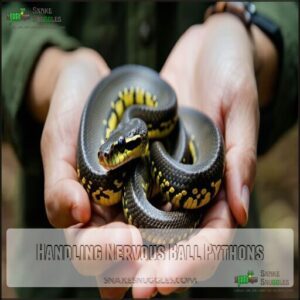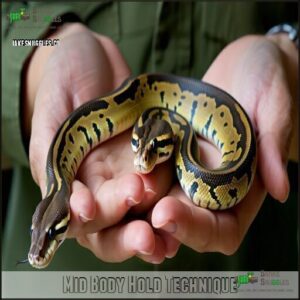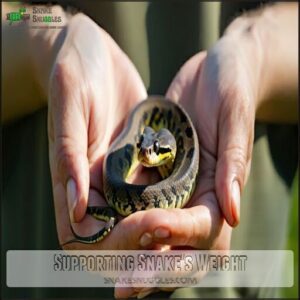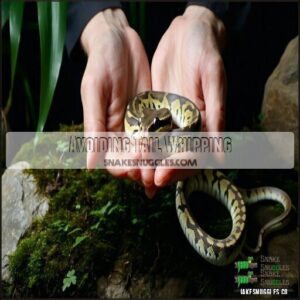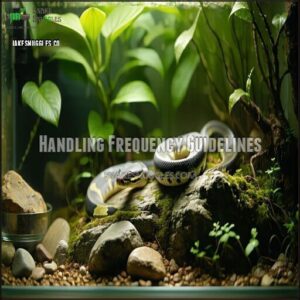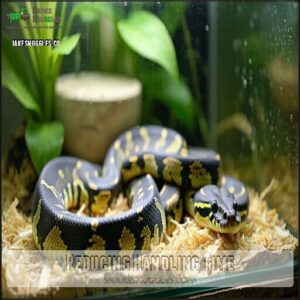This site is supported by our readers. We may earn a commission, at no cost to you, if you purchase through links.

Support your snake’s body fully, never grabbing or restraining it.
Start with short 5-10 minute sessions, gradually increasing as trust builds.
Wash hands before handling to remove unfamiliar scents.
Watch for stress signs like tight coiling, head hiding, or rapid tongue flicking.
If your python seems stressed, return it to its enclosure.
Never handle after feeding or during shedding.
Create a calm environment by minimizing noise and sudden movements.
Most ball pythons eventually calm down with consistent, gentle handling—turning even the shyest snakes into comfortable companions through patience and respect.
Table Of Contents
- Key Takeaways
- Handling Nervous Ball Pythons
- Pre Handling Precautions
- Safe Handling Methods
- Taming and Socialization
- Handling Frequency Guidelines
- Environmental Enrichment
- Calming Stressed Snakes
- Handling Young Ball Pythons
- Long Term Care Considerations
- Frequently Asked Questions (FAQs)
- How do you handle a ball python?
- How do you care for a ball python?
- Can a ball python be handled too much?
- What should I do if my ball python is agitated?
- How do you train a ball python?
- Can a ball python be injured?
- How to calm a stressed ball in python?
- How do you calm a nervous snake?
- How to handle a royal python?
- How to handle during shedding cycle?
- Conclusion
Key Takeaways
- Move slowly, support the snake’s body fully, and avoid sudden movements to help your python feel secure.
- Watch for stress signs like tight coiling, head hiding, or rapid tongue flicking and adjust your handling accordingly.
- Keep handling sessions short, starting with 5-10 minutes, and gradually increase as the snake becomes more comfortable.
- Avoid handling during shedding, after feeding, or when the snake shows clear stress signals to prevent discomfort or harm.
Handling Nervous Ball Pythons
When handling a nervous ball python, it’s important to approach calmly and use gentle, consistent techniques.
Recognizing signs of stress and adjusting your actions can help your snake feel more secure and build trust over time.
Approach and Handling Techniques
When handling a nervous snake, use a gentle approach and confident handling to build trust.
Always minimize startling by moving slowly and staying visible. Secure support is key—use both hands to evenly hold the snake’s mid-body.
Consistent handling in a calm environment helps reduce snake anxious behavior. Avoid sudden grabs, which can trigger signs of fear or stress.
Recognizing Stress Signs
Recognizing stress signs in a nervous snake is essential. Look for coiling behavior, hiding signals, or body flattening, which indicate snake anxiety.
Rapid tongue flicking shows heightened sensory awareness, while irregular breathing patterns suggest discomfort. Signs of fear, like staying motionless or mock striking, are common stress indicators.
One physical sign may include regurgitation after feeding, which helps you understand that addressing your ball python’s needs effectively is crucial. Understanding these stress signs and recognizing heightened sensory awareness helps you take appropriate action.
Minimizing Stress Triggers
To minimize stress triggers, create a calm environment by reducing noise and controlling vibrations near the enclosure.
Make certain the snake feels secure with proper visual security, like covered tank sides.
Handle consistently but avoid sudden movements or unfamiliar scents that may trigger nervous behavior.
Always provide a safe space where signs of fear, like tight coiling, can ease naturally, ensuring the snake’s well-being in a secure and stress-free environment.
Pre Handling Precautions
Before handling your ball python, make sure your hands are clean to avoid transferring harmful bacteria. Move slowly and provide proper support to keep your snake comfortable and reduce stress.
Washing Hands Thoroughly
Before handling, wash your hands thoroughly with soap and water to maintain hygiene and prevent salmonella.
This step reduces bacteria and guarantees snake safety. If soap isn’t enough, use sanitizer with at least 60% alcohol for added protection.
For extra caution, consider glove usage. Proper hygiene practices protect you as well as keep your ball python healthy and stress-free.
Avoiding Sudden Movements
When handling your ball python, avoid sudden movements to keep a calm environment. Use predictable patterns and slow lifting to reduce snake stress.
Gentle handling with visual cues helps your snake feel secure. Quick grabs or jerky actions can startle them, increasing anxiety.
Always approach with a calm demeanor, ensuring smooth, deliberate motions for stress reduction and a more relaxed snake-handling experience.
Using Proper Support
After avoiding sudden movements, focus on proper support to keep your ball python comfortable.
Use both hands to guarantee even weight distribution and body alignment.
Follow these snake handling techniques:
- Maintain a secure grip without squeezing to prevent injury.
- Support the snake’s mid-body and tail for stability.
- Handle with confidence to build trust and guarantee safe handling.
Safe Handling Methods
When handling a nervous ball python, it’s important to use safe and gentle techniques to keep them calm.
Supporting their weight properly and using a mid-body hold can help minimize stress and prevent defensive behaviors.
Mid Body Hold Technique
The mid-body hold is key to safe ball python handling. Place your hands gently around the snake’s midsection, guaranteeing a secure grip without applying pressure.
This handling technique keeps the snake calm and comfortable. Always use a gentle lift, letting it move naturally. A calm snake responds better, so prioritize body support for snake comfort.
| Do’s | Don’ts | Why It Matters |
|---|---|---|
| Use a secure grip | Squeeze tightly | Guarantees snake comfort |
| Lift gently | Pull abruptly | Reduces stress |
| Support mid-body | Grab near the head | Promotes safe handling |
| Stay calm | Make sudden moves | Keeps the snake relaxed |
Supporting Snake’s Weight
When lifting your ball python, body support is everything.
Use both hands to create a comfortable hold, ensuring the snake feels secure. Proper grip under the midsection and along its length prevents stress and avoids injury.
Safe handling means letting the snake rest naturally in your hands, avoiding dangling or uneven weight distribution. Gentle handling techniques build trust over time, and this is crucial for the well-being of the snake, as it allows for proper grip.
Avoiding Tail Whipping
Watch for tail whipping—it’s a clear stress sign and defensive behavior.
Use a gentle approach and secure hold to reassure your python. Support its body evenly, avoiding sudden movements that might escalate its reaction.
A calm environment helps reduce stress, allowing you to read its body language better. Mastering handling techniques builds trust and minimizes defensive behavior during snake handling sessions, which is key to a successful and safe interaction, ensuring a calm environment.
Taming and Socialization
Taming your ball python takes patience and consistent effort to build trust. Gradual exposure and gentle handling help your snake feel secure and comfortable over time.
Gradual Exposure
When handling a nervous ball python, start with gradual exposure. Spend time near the enclosure (habitat proximity) to let your snake adjust to your presence.
Use scent introduction by letting it recognize your smell. Follow the snake’s pace, keeping interactions slow and calm.
Minimal handling at first builds trust and creates positive associations, helping reduce python nervous behavior while ensuring python handling safety.
Positive Reinforcement
Positive reinforcement helps with python trust building. Create a calm environment by using gradual progression during interactions.
Scent familiarization and treat association can reward docility. While clicker training isn’t practical for snakes, consistent handling in a calm environment helps.
Gradual exposure reduces fear, allowing the snake to associate handling with safety. Remember to support snake bodies fully during handling.
Always prioritize python calming techniques to guarantee a stress-free experience.
Building Trust
Building trust with your ball python takes time and consistent interaction.
Start with scent familiarization and a gradual approach, letting the snake recognize you as safe.
Positive association, like calm handling techniques, helps reduce stress signs.
Python behavior improves when patience is prioritized. Handle gently and regularly, respecting its limits.
Trust grows with steady, respectful ball python handling over time.
Handling Frequency Guidelines
Handling your ball python the right number of times each week is essential for its well-being. Striking a balance prevents stress while helping your snake stay comfortable with human interaction.
Handling Sessions Per Week
How often should you handle your ball python? Aim for optimal frequency with 1-3 sessions weekly.
Keep handling consistency to build trust, but adjust for individual variation in temperament. Avoid handling during shedding or after feeding to prevent python stress.
Follow these steps:
- Start slow.
- Watch for stress signs.
- Handle post-shedding.
- Stay consistent.
- Prioritize a calm python.
Session Duration Limits
Keep handling sessions short to avoid python stress and overstimulation risks.
Adult ball pythons tolerate up to 20 minutes, while hatchlings need gentler care, with sessions under 30 minutes.
Watch for stress signs like handling fatigue or unusual post-handling behavior.
Gradual exposure helps, but overhandling can harm their trust and health, so stick to a consistent handling duration to maintain their comfort and avoid causing stress.
Avoiding Over Handling
After managing session duration, it’s important to prevent overhandling. Snakes thrive with balance.
Too much handling can cause stress signs like tight coiling or head hiding.
Follow these tips to avoid snake handling distress:
- Skip post-feeding handling for 48-72 hours.
- Limit sessions during shedding periods.
- Watch for fear signs, such as heavy breathing or quick movements.
This will help ensure a healthy and stress-free environment for your snake.
Environmental Enrichment
Creating a comfortable and stimulating environment helps reduce your ball python’s stress and keeps it happy.
By offering hiding spots, maintaining proper temperatures, and minimizing disturbances, you can support its natural behaviors and sense of security, which is crucial for its well-being, and this can be achieved by ensuring the environment is stimulating.
Providing Hiding Spots
Creating hiding spots is a must for stress reduction and a calm atmosphere.
Snakes need secure hides that fit snugly—think "cozy snake cave."
Size matters, so choose or make multiple hides to suit your python’s growth.
Many keepers purchase specialized python enclosures for their snakes.
Place these hides on both the warm and cool sides of the enclosure for safe space creation, promoting effective environmental enrichment.
Maintaining Temperature
Proper temperature regulation is key to a happy python. A temperature gradient guarantees comfort and digestion.
Set a warm basking spot to 90-92°F using a thermostat. The ambient temperature should stay around 82°F, with hide temperatures between 75-80°F.
Thermal gradients are vital for their well-being.
- Use thermostats for temperature control.
- Maintain a warm basking spot.
- Maintain stable ambient temperature.
- Monitor hide temperatures carefully.
Reducing Stress
A quiet environment works wonders for your nervous ball python.
You’ll want to minimize loud noises and vibrations near their enclosure. Gradual introduction to handling helps reduce stress – start with short sessions and slowly increase time.
Make certain their home has proper hiding spots on both warm and cool sides. Providing appropriate ball python hides is vital for their sense of security.
Watch for stress signals and adjust your approach accordingly. Always use gentle movements when approaching your snake’s secure enclosure to ensure a calm environment and reduce stress.
Tight Coiling
Wrapped in a tight ball, your ball python displays a classic sign of stress through increased coiling intensity.
When you notice this defensive posture with obvious muscle tension, it’s time for a snake handling break. Restricted movement indicates decreased comfort levels—this python nervous behavior requires immediate reassurance.
After any negative interaction, implement gradual introduction techniques when resuming contact.
Remember, a relaxed snake explores; a stressed one constricts itself protectively.
To reduce stress, consider offering varied hiding places within the enclosure, which can help alleviate stress and promote a sense of security and comfort.
Head Hiding
When your ball python tucks its head under its coils, it’s sending a clear "I’m scared" signal.
This head hiding behavior indicates your snake feels threatened and is trying to protect its most vulnerable body part.
You’ll want to provide secure hides throughout the enclosure to reduce fear.
Gradual exposure to handling and building confidence through consistent, gentle interactions helps minimize this nervous python behavior over time, which can be achieved by promoting a sense of security and using gentle interactions to build trust, ultimately leading to a confident snake.
Rapid Tongue Flicking
While head hiding signals fear, rapid tongue flicking tells a different story.
When your ball python’s tongue darts rapidly, it’s conducting an environmental assessment, collecting information about its surroundings.
This behavior often indicates anxiety or sensory overload.
You’ll notice increased flicking when there’s unfamiliar stimuli in their environment.
Consider this an early warning sign of defensive behavior, allowing you to address stressors before your snake becomes truly distressed.
Calming Stressed Snakes
When you notice your ball python showing signs of stress like tight coiling or head hiding, you’ll need to immediately reduce handling time and provide more secure hiding spots.
You can also help calm your nervous snake by keeping its environment quiet and maintaining consistent temperatures, which creates a sense of safety and security.
Reducing Handling Time
While a well-designed habitat reduces stress, sometimes your ball python needs a break from handling altogether.
If you notice python nervous behavior recognition signs, immediately shorten your sessions. Start with just 5 minutes and watch for stress signals.
Gradually increase time as your snake builds confidence. Some days, skip handling completely—observation through glass offers a python overhandling alternative that maintains your bond without triggering python snake anxiety.
Increasing Hide Options
Your nervous python’s safe haven needs multiple hiding spots to reduce stress.
Place at least two secure hides on opposite ends of the enclosure—one in the warm area and another in the cool section.
Choose hide materials like cork bark or commercial reptile caves that fit snugly against your snake’s body.
The right hide size matters; your python should touch all sides when curled inside for maximum security.
Minimizing Noise
Adding more hides helps, but you’ll also need to address noise issues.
Ball pythons are extremely sensitive to sounds and vibrations.
Keep your snake’s enclosure away from speakers, TVs, and high-traffic areas.
Sound dampening materials around the enclosure can reduce vibrations.
During handling sessions, choose a quiet room and turn off loud devices.
Recognizing python nervous behavior often starts with understanding their sensitivity to environmental noise and creating a truly calm atmosphere.
Handling Young Ball Pythons
You’ll want to limit handling sessions with young ball pythons to just once a week, keeping each interaction under 20 minutes to prevent stress.
Young snakes need more time to feel secure in their environment, so always support their entire body and watch for signs of discomfort like tight coiling or head hiding.
Handling Frequency
In the case of handling young ball pythons, frequency matters.
Limit handling hatchlings to just once a week, giving them time to feel secure in their environment.
For juveniles, keep handling intervals at 1-2 times weekly until they show comfortable python behavior recognition.
Always respect the post-feeding wait of 48-72 hours, and avoid handling during shedding, as over-handling risks include stress and potential feeding refusals.
So, patience pays off.
Handling Duration
Now that you’ve established a handling frequency, keep session length short for young ball pythons.
Limit handling duration to just 5-10 minutes initially. Your juvenile python can become overwhelmed quickly, leading to overstimulation risks.
As they acclimate, gradually extend sessions to 15 minutes maximum. Remember the post-feeding wait of 48-72 hours before any handling.
Short, positive interactions build trust without pushing your snake beyond its comfort zone, ensuring short handling sessions are beneficial.
Monitoring Stress
While handling your young ball python, watch closely for stress indicators.
Young pythons show stress differently than adults – look for rapid tongue flicking, tight coiling, or head hiding.
If you notice these python nervous behavior signs, return them to their enclosure immediately.
Environmental impact matters too – sudden temperature changes or loud noises can trigger fear signs.
Monitor feeding habits as well; refusing food often indicates your snake’s stress level is too high, which can be a key indicator of their overall well-being, including their ability to thrive in their environment with proper care.
Long Term Care Considerations
You’ll need to prepare for a 30-year commitment when owning a ball python, including consistent handling practices and proper environmental conditions.
Your long-term care plan should include budgeting for food, habitat maintenance, and veterinary visits to guarantee your nervous snake develops into a calm, healthy companion.
Planning for 30 Year Commitment
While young ball pythons need special handling, owning these remarkable creatures means thinking well beyond next year.
Ball pythons can live 20-30 years in captivity, making them a decades-long commitment.
Here’s what responsible ownership involves:
- Evaluate lifestyle changes (moving, marriage, children) that might impact care
- Identify a successor caregiver should you become unable to continue
- Research ethical reptilecare standards that evolve over time
- Join reptile communities for ongoing support
- Document your snake’s history, preferences, and care routine
Budgeting for Care
Budgeting wisely for ball python care means planning for decades of expenses.
You’ll need to allocate funds for food costs ($15-30 monthly), veterinary expenses ($100-200 annually), and occasional enclosure upgrades as your snake grows.
Create an emergency fund for unexpected health issues, and identify a successor caregiver who understands reptile care if you can’t continue.
Python care is affordable with proper planning, unlike some other pets.
Ensuring Proper Environment
Create a sanctuary that promotes your ball python’s wellbeing with proper enclosure size and temperature gradient.
Your nervous python needs at least 3-4 hiding spots distributed throughout warm and cool areas.
Maintain 50-60% humidity and follow a consistent 12-hour lighting schedule.
Environmental enrichment through various climbing branches and substrate depths helps reduce stress behaviors and creates a safe space your python will thrive in.
Consider a bioactive setup, where springtails manage waste, contributing to a healthier environment with proper waste management.
Frequently Asked Questions (FAQs)
How do you handle a ball python?
Like taming a gentle breeze, approach slowly from the side.
Support your ball python’s body with both hands.
Keep sessions under 20 minutes.
Wash hands before and after handling to prevent bacteria transfer.
How do you care for a ball python?
Provide proper housing with temperature gradients, clean water, and hiding spots.
Feed appropriate-sized mice regularly, maintain humidity levels, and handle your ball python gently.
Don’t forget regular health checks and careful monitoring of their behavior.
Can a ball python be handled too much?
Yes, your slithery friend can get "too much of a good thing."
You should limit handling to 1-2 times weekly for 20 minutes per session.
Avoiding feeding days and shedding periods is crucial to prevent stress.
This will help ensure your pet’s well-being and safety during interactions.
What should I do if my ball python is agitated?
Return your ball python to its enclosure immediately.
Give it space, dim the lights, and make certain the temperature is correct.
Wait at least 24 hours before attempting to handle it again.
How do you train a ball python?
Train your ball python through consistent, gentle handling sessions of 5-10 minutes, 2-3 times weekly. Allow acclimation periods, support their body fully, and move slowly to build trust over time.
Can a ball python be injured?
Ball pythons can be injured through improper handling, extreme temperatures, or inadequate enclosures.
They’re susceptible to scale damage, spine injuries, burns, and respiratory issues.
You’ll need to handle them gently and maintain proper environmental conditions.
How to calm a stressed ball in python?
Imagine your ball python as a shy friend.
Approach slowly and support their body fully.
Lower lighting, minimize noise, and use proper handling techniques.
Cover part of their enclosure and provide multiple hiding spots.
How do you calm a nervous snake?
Approach your nervous snake slowly with gentle movements.
Support its body fully, provide hiding spots, maintain proper temperature, and minimize handling during stress periods.
Wash hands before touching to remove unfamiliar scents, this helps to reduce stress and ensure the snake feels secure with gentle movements.
How to handle a royal python?
To handle a royal python, wash your hands first, then gently support its body with both hands.
Don’t grab suddenly or reach from above.
Keep sessions short and avoid handling after feeding or during shedding.
How to handle during shedding cycle?
During shedding, minimize handling your ball python.
Let them rest in peace until the process completes.
If you must handle them, keep it brief and support their body fully to avoid stress and skin damage.
Conclusion
Imagine building trust with a shy friend—it takes time, patience, and gentle effort.
Handling a nervous ball python is no different. By moving slowly, providing full support, and recognizing stress signs, you help your snake feel safe.
Stick to short, calm sessions, avoid sudden movements, and create a peaceful environment.
Over time, consistent, respectful handling builds trust. Your nervous ball python can grow into a relaxed, happy companion with care and dedication. Patience truly pays off.
- https://www.academia.edu/34449936/Animal_handling_techniques_snakes_totoise_and_small_birds
- https://iaabcjournal.org/enrichment-for-snakes/
- https://www.jabberwockreptiles.com/news/ball-python-temperature/
- https://reptifiles.com/ball-python-care-guide/ball-python-humidity-temperatures/
- https://www.zillarules.com/information/care-sheets/ball-python

